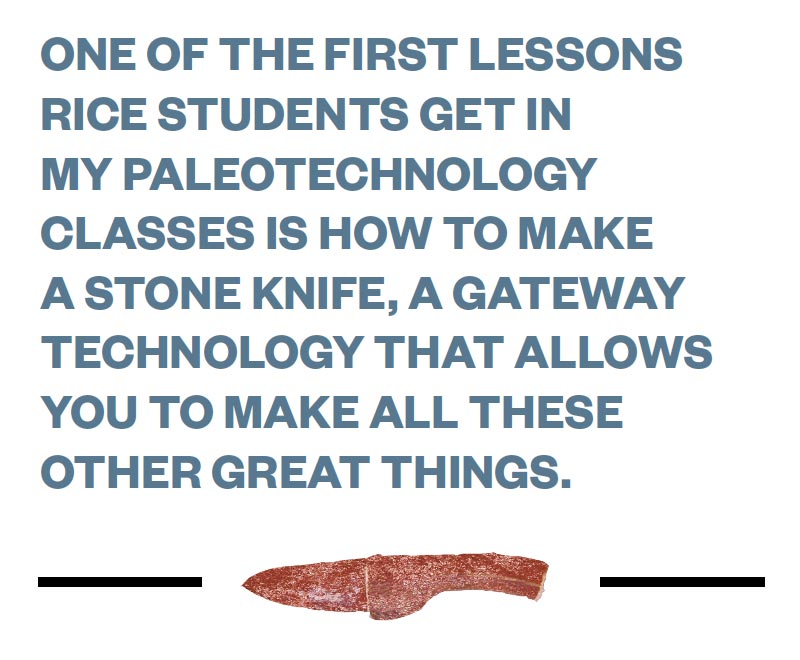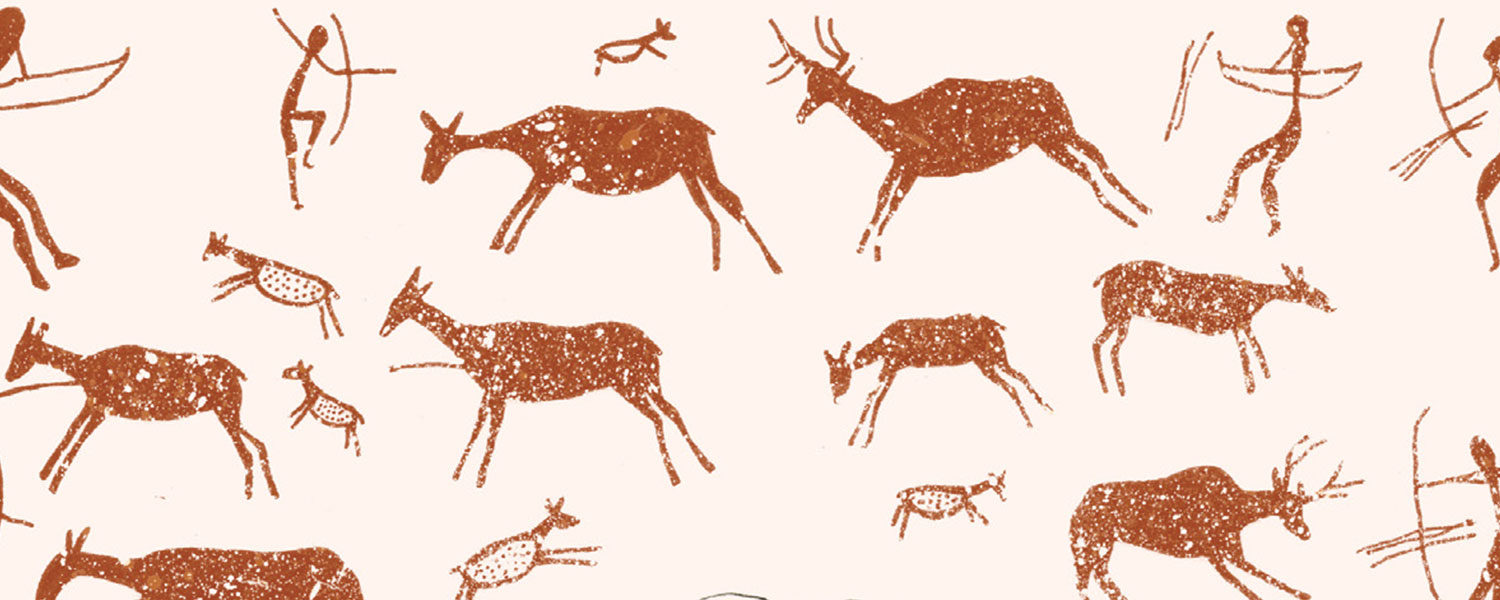August “Gus” Costa spends a lot of time thinking about the past in innovative ways. As a paleoanthropologist, Costa studies “bones and stones,” artifacts that tell a story about the earliest human societies. A lecturer in Rice’s Department of Anthropology, Costa’s teaching mission, he said, is “to inspire others with wonder for the past.” Last fall, he taught Paleotechnology (ANTH 384), part of a broader archaeology curriculum that emphasizes experiential learning. “Our ancestors invented inventing. What better way for students to gain unconventional knowledge than to experience the technological foundations of humanity?”
IN THE STONE AGE
Most people’s exposure to the Stone Age and stone tools is through cartoons of guys chipping out stone wheels, things that are total misconceptions. You don’t get stone wheels until after the Stone Age, some 6,000 years ago, and they are made of wood, not stone. The Stone Age is 3.3 million years ago until 10,000 years ago — that is 99.7 percent of human cultural history.

August “Gus” Costa
TEACHING PALEOTECHNOLOGY
Paleotechnology can be taught as a boring lecture-style class, but I don’t think the students will get much out of it. So I try to blow the students’ minds to show them something that they never thought was possible. The students get to discover how to make fire by friction, and they learn to make string and glue from plants on campus.
SCHOOL OF HARD ROCKS
Most of our lessons begin with a reminder that we are spoiled. It’s so easy to go and buy a container at the Container Store or IKEA. People don’t really appreciate how difficult it was to have to grow your gourd container or find an ostrich egg and make it into a container or weave the container, then line it with pine pitch to make it waterproof. Appreciating the past helps us value what we really have.
GATEWAY TECHNOLOGIES
One of the first lessons Rice students get in my paleotechnology classes is how to make a stone knife, a gateway technology that allows you to make all these other great things. You can work wood and make a lot of different types of wood tools once you have the stone tools.
THE ART OF FLINTKNAPPING
Flintknapping (the production of chipped stone tools from flint or flint-like rocks) can definitely be thought of as an art because it takes quite a bit of skill to make these artifact replicas. It is essentially stone sculpture, but it’s not as forgiving as carving out a piece of marble, for instance. These stones shatter like glass, so if you break a stone in the wrong way, the whole thing could be ruined.

FORAGING AND SURVIVING
I buried a bunch of potatoes on the south side of campus near the medical center. It was a scavenger hunt meant to reinforce our assigned reading on basic foraging. The students used digging sticks to dig up potatoes like huntergatherers who forage for wild plant tubers. The students had all been sorted into different bands, which competed in class activities (like on the TV show ‘Survivor’) for extra credit.
LEARNING FROM STUDENTS
I have one student who is doing a class research project on pyrite firestarters. You can make a primitive fire striker with any iron sulfide mineral and a hard rocklike flint. I had not realized that there was an archaeological record for those things in the later Stone Age of Europe. When students pick up on projects that I wouldn’t come up with, and we learn new things together, that is something I really appreciate.
WILL THIS HELP ME AFTER THE APOCALYPSE?
When I explain what I do, a lot of people immediately identify how it might be useful in a postapocalyptic world. There are folks who think the Stone Age is important because you can get tips on how to survive in the wild. That is certainly true, because sallyport there are practical aspects to being able to make a stone knife or string.
For those of us who are focused on prehistoric archaeology, especially the Stone Age, what we are studying is the prehistory of survivalism. These guys put any of these celebrity survivalists to shame. We know that they were the best survivalists because we’re here.
NO, BUT A COMMUNITY WILL.
One of the most important things for paleotechnology to work is that you have to have a group. The false idea that one should be able to survive alone really doesn’t have any basis if you look at the archaeological record, because we know that humans are social animals. If you were isolated in the past, that essentially meant death, because you needed a group to survive.
— Sukhada Tatke
A TEACHING FUND
From ostrich eggs to flint flakers, the teaching materials used in August Costa’s new course in ancient technology are both pricey and hard to find. To launch the course (and keep his students supplied with atlatl darts), Costa applied for and received one of eight coveted Brown Teaching Grants, which are awarded annually to support excellence in undergraduate teaching and can total up to $5,000. The wide-ranging grants also supported projects to translate a 19th-century Spanish novel into English, create a nanomaterials laboratory course, pilot language learning software to improve international students’ speaking skills and participate in a premier synthetic biology competition.






